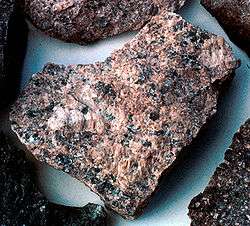Sial
In geology, the term 'sial' refers to the composition of the upper layer of the Earth's crust, namely rocks rich in silicates and aluminium minerals. It is sometimes equated with the continental crust because it is absent in the wide oceanic basins,[1] but "sial" is a geochemical term rather than a plate tectonic term.[2] As these elements are less dense than the majority of the earth's elements, they tend to be concentrated in the upper layer of the crust.

The uppermost layer of the crust is called sial consisting of silicate and Aluminium (Si =silicate, Al= aluminium). On an average, the thickness of sial is till 25 km from the surface. The continents are composed mainly of lighter Rock material formed from silicon and Aluminium, so the sial Is thick over the continents and very thin or absent on the ocean floor especially the Pacific Ocean. Average density of sial is 2.7 gm/cc.
Geologists often refer to the rocks in this layer as felsic, because they contain high levels of feldspar, an aluminium silicate mineral series. However, the sial "actually has quite a diversity of rock types, including large amounts of basaltic rocks."[3]
The name 'sial' was taken from the first two letters of silica and of alumina. The sial is often contrasted to the 'sima,' the next lower layer in the Earth, which is often exposed in the ocean basins; and the nickel-iron alloy core, sometimes referred to as the "Nife". These geochemical divisions of the Earth's interior (with these names) were first proposed by Eduard Suess in the 19th century. This model of the outer layers of the earth has been confirmed by petrographic, gravimetric, and seismic evidence.[4]
Properties
Sial has a lower density (2700–2800 kg/m3[5]) than sima, which is primarily due to increased amounts of aluminium, and decreased amounts of iron and magnesium. The base of the sial is not a strict boundary, the sial grades into the denser rocks of the sima. The Conrad discontinuity has been proposed as the boundary, but little is known about it, and it doesn't seem to match the point of geochemical change.[6] Instead, the boundary has been arbitrarily set at a mean density of 2800 kg/m3.[3]
Because of the large pressures, over geologic time, the sima flows like a very viscous liquid, so, in a real sense, the sial floats on the sima, in isostatic equilibrium.[7] Mountains extend down as well as up, much like icebergs on the ocean;[7] so that on the continental plates the sial runs between 5 km and 70 km deep.[8]
See also
| Look up sial in Wiktionary, the free dictionary. |
Notes and references
- Continental crust has been defined as That type of the Earth’s crust which underlies the continents and the continental shelves: it is equivalent to the sial. Neuendorf, Klaus K. E.; Mehl, James P.; Jackson, Julia A., eds. (2005). Glossary of Geology (5th ed.). Alexandria, Virginia: American Geological Institute. p. 139. ISBN 978-3-540-27951-8.
- Smith, Frederick Gordon (1963). Physical Geochemistry. Reading, Massachusetts: Addison-Wesley. p. 379. OCLC 253612701.
- Ritter, Michael E. (2006). "Chapter EM: Earth Materials and Structure: The Earth's Interior: The Crust". The Physical Environment: An Introduction to Physical Geography. Archived from the original on 11 November 2007.
- Kuenen, Philip Henry (1950). Marine Geology. New York: Wiley. p. 117. OCLC 489742.
- Fairbridge, Rhodes W., ed. (1967). The Encyclopedia of Atmospheric Sciences and Astrogeology. New York: Reinhold Publishing. p. 323. OCLC 430153.
- Monastersky, Richard (1989). "Inner Space". Science News. 136 (17): 266–268, page 266. doi:10.2307/3973827. JSTOR 3973827.
- Bridges, Edwin Michael (1990). World Geomorphology. Cambridge, England: Cambridge University Press. p. 13. ISBN 978-0-521-38343-1.
- Lliboutry, Luis (2000). Quantitative Geophysics and Geology. London: Springer-Praxis. p. 152. ISBN 978-1-85233-115-3.
Sources
- Bates, R.L., and Jackson, J.A., (1987) Glossary of geology American Geological Institute, Alexandria, Virginia.
- Dilek, Y. and Newcomb, S. (eds.) (2003) Ophiolite Concept and the Evolution of Geological Thought Geological Society of America Special Paper 373, Boulder, Colorado.